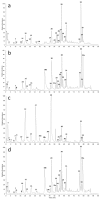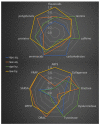Ripe and Raw Pu-Erh Tea: LC-MS Profiling, Antioxidant Capacity and Enzyme Inhibition Activities of Aqueous and Hydro-Alcoholic Extracts
- PMID: 30699941
- PMCID: PMC6384787
- DOI: 10.3390/molecules24030473
Ripe and Raw Pu-Erh Tea: LC-MS Profiling, Antioxidant Capacity and Enzyme Inhibition Activities of Aqueous and Hydro-Alcoholic Extracts
Abstract
Herein, we reported a detailed profiling of soluble components of two fermented varieties of Chinese green tea, namely raw and ripe pu-erh. The identification and quantification of the main components was carried out by means of mass spectrometry and UV spectroscopy, after chromatographic separation. The antioxidant capacity towards different radical species, the anti-microbial and the enzyme inhibition activities of the extracts were then correlated to their main constituents. Despite a superimposable qualitative composition, a similar caffeine content, and similar enzyme inhibition and antimicrobial activities, raw pu-erh tea extract had a better antioxidant capacity owing to its higher polyphenol content. However, the activity of raw pu-erh tea seems not to justify its higher production costs and ripe variety appears to be a valid and low-cost alternative for the preparation of products with antioxidant or antimicrobial properties.
Keywords: LC-MS.; anti-enzyme profile; antioxidant profile; raw pu-erh tea; ripe pu-erh tea.
Conflict of interest statement
The authors declare no conflict of interest.
Figures




Similar articles
-
Dynamic Profiling of Phenolic Acids during Pu-erh Tea Fermentation Using Derivatization Liquid Chromatography-Mass Spectrometry Approach.J Agric Food Chem. 2019 Apr 24;67(16):4568-4577. doi: 10.1021/acs.jafc.9b00789. Epub 2019 Apr 11. J Agric Food Chem. 2019. PMID: 30932482
-
Application of metabolomics in the analysis of manufacturing type of pu-erh tea and composition changes with different postfermentation year.J Agric Food Chem. 2010 Jan 13;58(1):345-52. doi: 10.1021/jf902818c. J Agric Food Chem. 2010. PMID: 19916505
-
Chemical constituents and biological properties of Pu-erh tea.Food Res Int. 2022 Apr;154:110899. doi: 10.1016/j.foodres.2021.110899. Epub 2021 Dec 15. Food Res Int. 2022. PMID: 35337597 Review.
-
Characteristics of probiotic yoghurts supplemented with Pu-erh tea infusion.Acta Sci Pol Technol Aliment. 2019 Apr-Jun;18(2):153-161. doi: 10.17306/J.AFS.0640. Acta Sci Pol Technol Aliment. 2019. PMID: 31256543
-
[The mechanisms of weight-cutting effect and bioactive components in Pu-erh tea].Dongwuxue Yanjiu. 2012 Aug;33(4):421-6. doi: 10.3724/SP.J.1141.2012.04421. Dongwuxue Yanjiu. 2012. PMID: 22855451 Review. Chinese.
Cited by
-
Effects of Geographical Origin and Tree Age on the Stable Isotopes and Multi-Elements of Pu-erh Tea.Foods. 2024 Feb 2;13(3):473. doi: 10.3390/foods13030473. Foods. 2024. PMID: 38338610 Free PMC article.
-
Possible Mechanisms of Dark Tea in Cancer Prevention and Management: A Comprehensive Review.Nutrients. 2023 Sep 7;15(18):3903. doi: 10.3390/nu15183903. Nutrients. 2023. PMID: 37764687 Free PMC article. Review.
-
Pu-erh tea extraction alleviates intestinal inflammation in mice with flora disorder by regulating gut microbiota.Food Sci Nutr. 2021 Jul 19;9(9):4883-4892. doi: 10.1002/fsn3.2437. eCollection 2021 Sep. Food Sci Nutr. 2021. PMID: 34532000 Free PMC article.
-
Investigations of Olive Oil Industry By-Products Extracts with Potential Skin Benefits in Topical Formulations.Pharmaceutics. 2021 Mar 30;13(4):465. doi: 10.3390/pharmaceutics13040465. Pharmaceutics. 2021. PMID: 33808196 Free PMC article.
-
Impact of tea leaves types on antioxidant properties and bioaccessibility of kombucha.J Food Sci Technol. 2021 Jun;58(6):2304-2312. doi: 10.1007/s13197-020-04741-7. Epub 2020 Sep 1. J Food Sci Technol. 2021. PMID: 33967327 Free PMC article.
References
-
- Chen H.-Y., Lin-Shiau S.-Y., Lin J.-K. Pu-erh Tea Its Manufacturing and Health Benefits. In: Shahidi F., Lin J.-K., Ho C.T., editors. Tea and Tea Products Chemistry and Health-Promoting Properties. 1st ed. CRC Press; Boca Raton, FL, USA: 2008. pp. 9–15.
-
- Zhang L., Zhang Z.Z., Zhou Y.B., Ling T.J., Wan X.C. Chinese dark teas: Postfermentation, chemistry and biological activities. Food Res. Int. 2013;53:600–607. doi: 10.1016/j.foodres.2013.01.016. - DOI
-
- Sun Q., Yan X.S. History of Pu’er Tea and comparative study for the effect of its various extracts on lipid-lowering diet. Pak. J. Pharm. Sci. 2014;27:1015–1022. - PubMed

